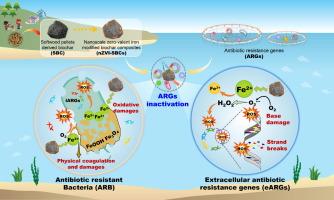Inactivation of antibiotic resistance genes by nanoscale zero-valent iron modified biochar composites: Synergistic effect of oxidative damage and physical destruction
IF 13.3
1区 工程技术
Q1 ENGINEERING, CHEMICAL
引用次数: 0
Abstract
Pollution of antibiotic resistance genes (ARGs) has become a challenge in the One Health era. Application of biochar-based materials is a strategy for controlling biological pollutants in water environment. However, the performance of nanoscale zero-valent iron (nZVI) modified biochar for inactivating antibiotic resistance bacteria (ARB) and extracellular ARGs (eARGs) in aquaculture environment is unknown. Therefore, a batch of nZVI modified softwood pellet derived biochar (SBC) composites (nZVI-SBCs) with different Fe: SBC mass ratio was synthesized to investigate their performance for inactivating E. coli HB101 and plasmid IE-V1955 as the correspondingly representative ARB and eARGs. The nZVI-SBCs with chain-like aggregates consisting of spherical nZVI dispersed on SBC surfaces contained high Fe0 content (28.2–33.3 %) and thin iron oxides layer. The nZVI-SBCs decreased E. coli HB101 number by 58.1–99.8 %, following an order of nZVI-SBC2 > nZVI-SBC1 > nZVI-SBC0.5. No regrowth of E. coli HB101 treated with nZVI-SBCs was observed. The inactivation of E. coli HB101 by nZVI-SBCs was attributed to the synergistic effect of cell membrane damages mediated by the extracellular ROS generation, intracellular ROS overproduction induced by Fe2+ overload, and bacterial coagulation by iron corrosion products. Moreover, nZVI-SBCs decreased the abundance of blaTEM-1 gene on plasmid IE-V1955 by 0.19–4.64 log, thus inhibiting their horizontal transformation. Inactivation of plasmid IE-V1955 was due to the strand breaks and base damages by the generated ROS from nZVI-SBCs. Density functional theory calculations results showed that •OH originated from nZVI-SBCs destroyed phosphodiester bond and hydrogen bond between G-C base pairs through dehydrogenation reaction. These findings expand the understanding of nZVI-SBCs inactivating ARG pollution, and also provide a practical strategy to mitigate ARG pollution in aquaculture environment based on biochar-based functional materials.

纳米级零价铁修饰生物炭复合材料对抗生素耐药基因的失活:氧化损伤和物理破坏的协同效应
抗生素耐药基因(ARGs)污染已成为“同一个健康”时代的挑战。生物炭基材料的应用是控制水环境中生物污染物的一种策略。然而,纳米级零价铁(nZVI)改性生物炭在水产养殖环境中灭活抗生素耐药菌(ARB)和胞外ARGs (eARGs)的性能尚不清楚。因此,合成了一批不同Fe: SBC质量比的nZVI改性软木颗粒衍生生物炭(SBC)复合材料(nZVI-SBC),考察其灭活大肠杆菌HB101和质粒IE-V1955的性能,作为相应的ARB和eARGs的代表。由球形nZVI组成的链状团聚体分散在SBC表面的nZVI-SBC具有高Fe0含量(28.2 ~ 33.3 %)和薄氧化铁层。与nZVI-SBC2 >; nZVI-SBC1 >; nZVI-SBC0.5的顺序相比,nzvi - sbc降低大肠杆菌HB101的数量为58.1 - 99.8% %。用nzvi - sbc处理大肠杆菌HB101未观察到再生。nzvi - sbc对大肠杆菌HB101的失活是由胞外ROS生成介导的细胞膜损伤、Fe2+超载诱导的胞内ROS过量以及铁腐蚀产物引起的细菌凝血的协同作用造成的。此外,nzvi - sbc使质粒IE-V1955上blatem1基因的丰度降低了0.19-4.64 log,从而抑制了质粒IE-V1955的水平转化。质粒IE-V1955的失活是由nzvi - sbc产生的ROS引起的链断裂和碱基损伤引起的。密度泛函理论计算结果表明,源自nzvi - sbc的•OH通过脱氢反应破坏了G-C碱基对之间的磷酸二酯键和氢键。这些发现扩大了对nzvi - sbc灭活ARG污染的认识,也为基于生物炭基功能材料减轻水产养殖环境中ARG污染提供了实用策略。
本文章由计算机程序翻译,如有差异,请以英文原文为准。
求助全文
约1分钟内获得全文
求助全文
来源期刊

Chemical Engineering Journal
工程技术-工程:化工
CiteScore
21.70
自引率
9.30%
发文量
6781
审稿时长
2.4 months
期刊介绍:
The Chemical Engineering Journal is an international research journal that invites contributions of original and novel fundamental research. It aims to provide an international platform for presenting original fundamental research, interpretative reviews, and discussions on new developments in chemical engineering. The journal welcomes papers that describe novel theory and its practical application, as well as those that demonstrate the transfer of techniques from other disciplines. It also welcomes reports on carefully conducted experimental work that is soundly interpreted. The main focus of the journal is on original and rigorous research results that have broad significance. The Catalysis section within the Chemical Engineering Journal focuses specifically on Experimental and Theoretical studies in the fields of heterogeneous catalysis, molecular catalysis, and biocatalysis. These studies have industrial impact on various sectors such as chemicals, energy, materials, foods, healthcare, and environmental protection.
 求助内容:
求助内容: 应助结果提醒方式:
应助结果提醒方式:


